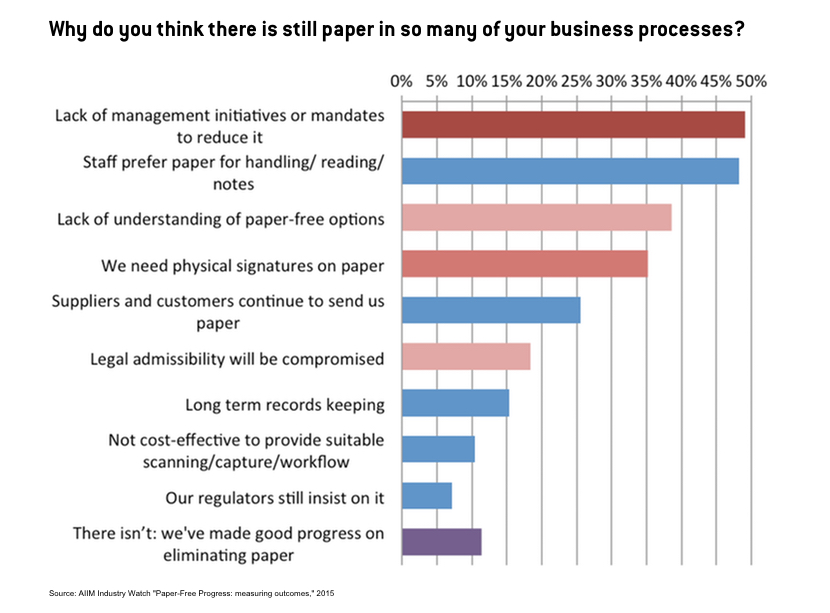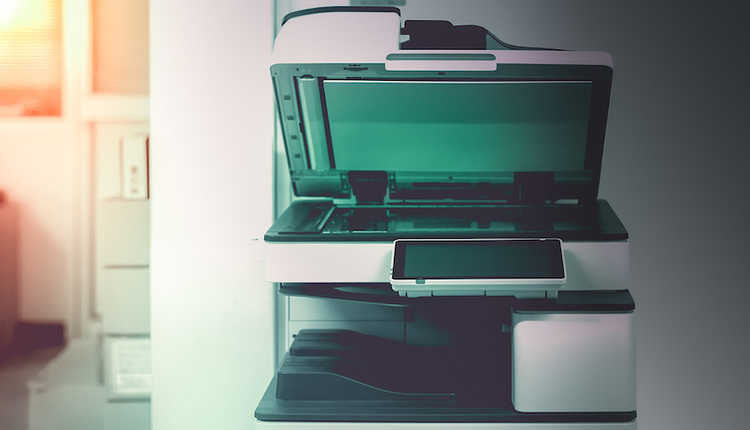
Image by: g-stockstudio, ©2015 Getty Images
With this in mind, we are finding that businesses are more readily accepting paper reduction from the business process rather than just for the sake of reducing storage costs—a best practice that should be considered. Yet, even those who have transformed their back-office processes are still wrestling with the elements of what I consider to be cultural when it comes to total elimination of paper-based content from their business processes.
All too often, we hear people say that they like paper and feel it is more tangible; yet, the reality is that people get comfortable in what they do and how they work. As a result, we have a challenge in changing the culture to accept paperless as the new way of working.
So, how does one initiate this type of change? In AIIM’s recent research report titled “Paper-Free Progress: measuring outcomes,” we asked why there is still so much paper in business today. Respondents said that one of the biggest barriers to paper reduction is a lack of management initiatives or mandates. Additionally, 39% feel there is a lack of understanding of paper-free options and a perceived need for physical signatures by 35% of respondents.

There is little to no reason why most paper documents are still needed in business today. Yes, there may be an exception or two, but in reality, most paper can be eliminated.
I encourage you to test the waters and eliminate just one piece of paper from your processes. Look at the process, identify the sources of paper, pick one and work to eliminate it. Once you have, assess the ways you can further improve upon what you have done. Do not do this in a vacuum. Engage the parties involved in this process and solicit their feedback on how to go about it. Making them a part of it is important to change management and changing their mindset. It is not a simple process, but it is one proving to be of great benefit. Who knows—in the future when I ask about your paper process, you may be one who says, "We no longer have that issue."

In my view, taking this step toward being paper-free should be a natural one—much like we have already done so in our personal lives. Many of us no longer cringe when asked to sign at the register when making a retail purchase. We have accepted this as a common practice, even to the degree that we do so outside of brick-and-mortar environments. Have you ever made a purchase at a craft fair, art festival or open markets and been asked to use your finger to sign via the mobile device used to record the transaction on your credit card? Typically, you are then asked if you want the receipt emailed to you. For many reading this, the answer is yes. So, I ask you: What is stopping you from going paperless in the office?
There is little to no reason why most paper documents are still needed in business today. Yes, there may be an exception or two, but in reality, most paper can be eliminated.
I encourage you to test the waters and eliminate just one piece of paper from your processes. Look at the process, identify the sources of paper, pick one and work to eliminate it. Once you have, assess the ways you can further improve upon what you have done. Do not do this in a vacuum. Engage the parties involved in this process and solicit their feedback on how to go about it. Making them a part of it is important to change management and changing their mindset. It is not a simple process, but it is one proving to be of great benefit. Who knows—in the future when I ask about your paper process, you may be one who says, "We no longer have that issue."
Bob Larrivee is vice president of market intelligence at at AIIM and an internationally recognized subject matter expert and thought leader with over 30 years of experience in the fields of information and process management. He is an avid techie with a focus on process improvement and the application of advanced technologies to enhance and automate business operations. Follow him on Twitter @BobLarrivee.
















